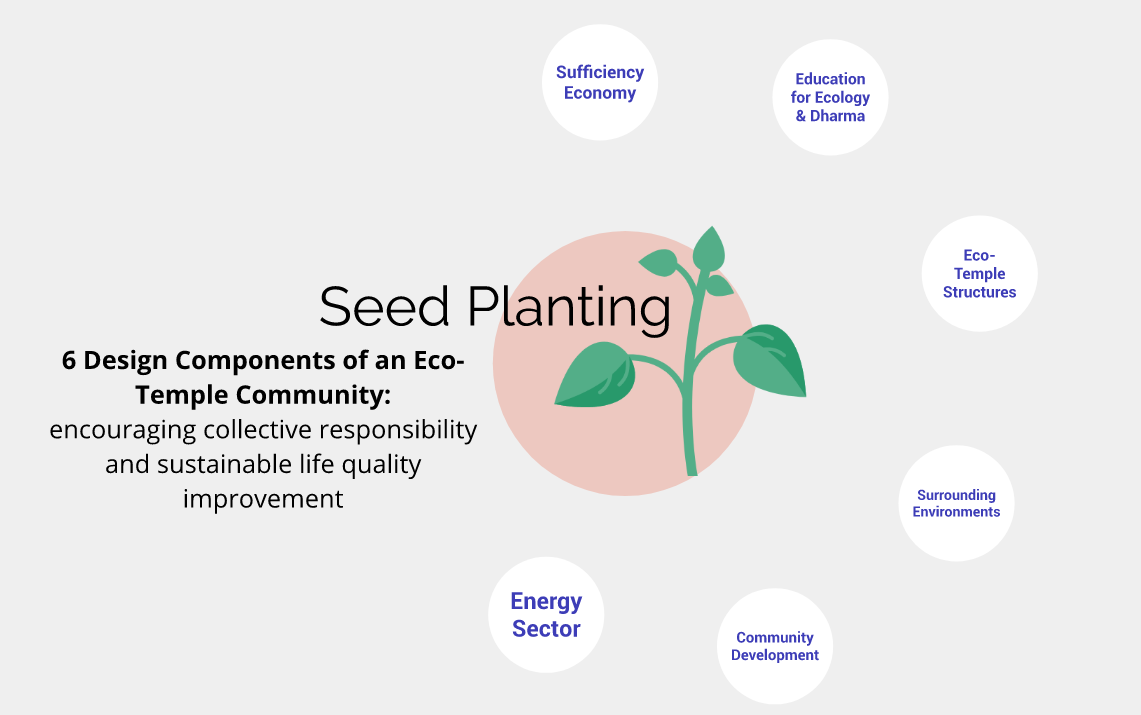The Definition of Eco-Temple
The specific goal of the project is to initiate and realize holistic Eco-Temple Communities based out of Buddhist temples (and applicable to the centers of other religions) in the INEB and ICE network. INEB and ICE members have a wide variety of communities, resources, and needs. By working together to develop an Eco-Temple Community Design Scheme, an information base of best practices and available resources can be developed for each community’s specific needs. The overarching goal is to develop ecological human communities that are sustainably interconnected with the natural environment through the community center of a religious facility/temple. Such religious centers will manifest ecological standards on the material, relational, and spiritual levels:
- Material: design, building materials, energy usage, waste management, economic sustainability, and connection to outer environment through gardens, agriculture, and forestry/water management
- Relational: community solidarity and interconnection through participation in various temple based ecological activities, including education and linkages with CSOs, government, and business
- Spiritual: cultivating the inner ecology of community members through spiritual practice and teachings that relate to ecological issues, which forms the basis of realizing the relational and material goals through grounded human interaction
The Eco Temple Community Design is a holistic development process that involves much more than simply putting solar panels on the roofs of temples. It involves a comprehensive integration of: 1) ecological temple structure and energy system, 2) economic sustainability, 3) integration with surrounding environment, 4) engagement with community and other regional groups (civil society, business, government), and 5) development of spiritual values and teachings on environment, eco-dharma. In this way, we are planning to move forward in supporting the creation and/or continuing development of holistic eco-temple communities based out of Buddhist temples (and applicable to the centers of other religions) in the INEB and ICE network.
As a faith based network, INEB and ICE see one of their key contributions to social change as the reform and revival of our Buddhist and spiritual traditions, especially in this case, the community and the physical presence of a holistic and ecologically minded religious center/temple. Through the religious center/temple, we can contribute greatly to the critical need for education and practice of inner ecology, while connecting that to outer ecological activities, such as community mobilization on environmental issues, right livelihood, and, foremost for this project, the establishment of a zero-waste, clean energy temple structure integrated into the local environment. From such a movement, religious communities can have a progressive role, contribution, and linkages with wider movements for ecological design and post-industrial societies, critical to the immediate global environmental crisis.
In this way, we will seek to develop the Eco-Temple Community Development Project more as a meme, or as a method or path, rather than as a fixed project with fixed membership. This means that we will try to further develop the Eco-Temple Community Design Scheme so that it can be used as a planning and action tool for our own and any other eco-temple community initiatives in the world. We hope to continue to enrich the design scheme and further our own work based on a number of cooperative agreements mentioned in the temple community profiles below and through an ongoing series of small meetings and site visits (often with a particular learning theme) as follows:
“Seed Planting”
As seen in the 5 core components of the Eco Temple Community Design, there are a wide variety of methods of engagement to realize a full-fledged eco temple community. “Seed Planting” can also start with other initiatives in Eco Temple Community Design, such as establishing Sufficiency Economy schools as with out member Phra Sangkom Khunsiri’s Temple of Buddha Relics and Smart Pagoda, There are also a huge number of potential sites for the work through the ICE and INEB Networks. INEB itself, as a predominantly Buddhist based network, has affiliates, members, and extended connections to temples throughout all of Buddhist Asia. These include extremely sensitive environmental areas, such as the Himalayas and the Mekong Delta, and areas of dense population where the human environmental footprint needs to be drastically reduced, such as India and China. The potential of just Buddhist temples, not to mention all religious facilities, to act as centers for lifestyle change in terms of energy use and environmental preservation is needless to say immense.
With this tremendous scope in mind, the Eco-Temple Community Development Project seeks to proceed step by step, temple by temple, by establishing a core foundation in a secretariat and its principal member temples. With the establishment of a secretariat and full time coordination, the essential work of 1) documentation of activities, 2) coordination of technological and methodological inputs in the network, and 3) coordination of site visits and conferences can be accomplished. The project, however, does not seek a funding model based on an annual budget for activities and administrative costs, which while yielding tangible outcomes does not create further financial resources and hence needs constant replenishing. Instead, using the model of solar “seed planting” mentioned above, the project seeks to secure single time donations towards the construction of solar facilities, ultimately enabling the temples in the network, like Zhengjue Temple in China, to in turn become “seed planters” for new temples in the network. This financial model has already been successfully achieved by Rev. Hidehito Okochi who not only has used the profits of his solar facilities to run a local environmental CSO but used the Buddhist practice of generosity (dana) and support for the local temple by its lay people to raise capital for the initial installation of solar panels.


